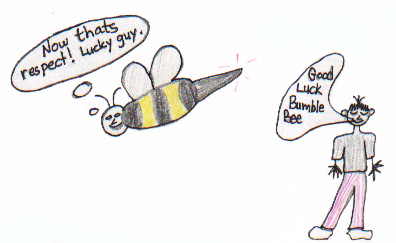Killer Bees of America:
KILLER BEES OF AMERICA
When killer bees were harrassed by noise and disturbance caused by uncautious humans, seconds later. bees swept out of their nest in formation and attacked with great aggression. After using their stingers against their enemy, many flew off. Others who had lost their stingers hung around the vicinity because they were going to die. A number of attacks by both humans and bees have occurred during the fall migration.
Thousands of bees have died during the migration, though no humans have died. They only suffered from the excruciating pain from the poison injected by the now dead bees.
Such attacks by these human creatures bring aggressive kamikaze attacks by the migrating bees. Very few other creatures challenge us or get in our way. Encounters causing unnecessary attacks can be avoided by simply treating us with respect.
by Gary Kameroff
|  This collection of student work is from Frank Keim's classes. He wants to share these works for others to use as an example of culturally-based curriculum and documentation. These documents have been OCR-scanned and are available for educational use only.
This collection of student work is from Frank Keim's classes. He wants to share these works for others to use as an example of culturally-based curriculum and documentation. These documents have been OCR-scanned and are available for educational use only.



